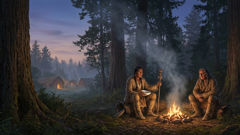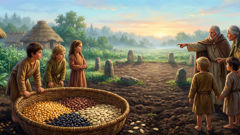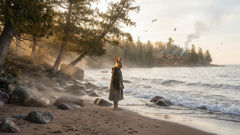Introduction
When the maples shed their last bright leaves and the lake glassed itself into a mirror of moon, the old people would lean forward and speak in the softened hush that comes before fear and blessing. They called the story by a dozen names, but every breath of the telling settled on the same hard thing: a head, whole in its expression though parted from the body, flying through the night with a hunger not easily named. Mothers tugged blankets up under chins; hunters checked the fit of straps and cords; children tucked hair behind ears to keep the telltale warmth from escaping—a superstition, they would tell you, rooted in courtesy and in fear. The Flying Head came without footsteps. It carried the smell of old blood and wet moss. It hunted not only for food but for the warmth of living flesh and for the voices that had wronged it in life. On clear nights its outline would be a crescent of mist and hair against the stars; on thick, cloudy nights it moved like a rumor under the eaves. This is a story meant to pinch the skin and quicken the pulse, yes, but it is also a caution about how ancestors are remembered, how debts are paid, and how a community's small rituals can keep a long, hungry thing at bay. I tell it now—slowly, with details some elders demanded be kept alive and others warned against—because the landscape that bore the tale still breathes and because some nights, when the wind rides down from the hills and the moon hides its face, it is only stories that stand between us and something that would rather have our warmth than our words.
Origins and Oaths
The oldest tellings trace the Flying Head to a breach of hospitality so severe it split the proper order of life and death. In the cold piecing of memory, the story begins with a man who was neither wholly stranger nor wholly kin. He arrived in a village bent and hungry as frost, with winter pressing at his heels and a story that required no proof: a lost sibling, a long journey, the fine print of misfortune. He was offered a fire and the edge of a sleeping mat, bread and broth measured in the way that communities measure the last gratitudes of a day. For a time he lived as all guests live—under the watchful eye of the household's oldest woman, cared for with the right rituals of tobacco and grateful nods. But one night, when the household was thinned by work and the man had consumed his welcome like heat, he was seen striking at a child in the dark. The wound was a small thing, the old tellers would say, but such an act unthreaded the bonds of trust in a way that could not be mended by apology alone.

The man died before his story found its finish. Whether disease, frost, or a reckoning by kin took him mattered less than what the elders insisted followed: his head refused to settle. It left the small, cold body and rose in a way that made the dogs whine, and then it flew. Some attributed the transformation to a curse—an oath broken, a table turned to insult—and some laid the blame on the dark places a person carries when they are refused every ordinary remedy. The lore is careful and stubborn here: it does not claim to know the exact mechanics of such a metamorphosis. Instead, it piles details that are meant to teach. When a person is denied the right fare of ceremony, when the names of the dead are spoken as grievances rather than with duty, something grows in the hearing that cannot be easily named. That thing might become a hunted shape.
Across many nights of telling and retelling, the Flying Head assumed certain traits. It retained the face it had in life, a face that might be familiar in some versions—a furrow between eyebrows, a missing canine, a scar along the jaw—and hair that fanned and streamed like seaweed. It carried hunger as other animals carry hunger, but it also collected memory. Those who glimpsed it said it had a voice, thin as smoke and sharp as flint, murmuring the names of those who had wronged it and those who had looked away. The head's flight was strangely deliberate; it did not simply drift but hunted along paths that people traveled. It sought warmth: a hearth where a body had been given no rose or bowl at the end, a house where an unatoned slight had been allowed to stand like rot. The community learned, through ache and ceremony, that the Flying Head was not random in its malice. It hunted grievances.
To live under that knowledge is to realize the small work of justice: naming, feeding, and tending to the dead are not mere customs but shields. The elders insisted on practices that would buy a village time. Cornmeal scattered at thresholds, a pinch of tobacco left on a stump, a whispered restitution when a slight had been inflicted—these were not empty. The Flying Head could be distracted by offerings, but only briefly. It hungered for what it could not be given: the company of a whole body and the ritual warmth of being properly seen. Sometimes a story would pivot and teach an act of cunning: a hunter once carried a hollow gourd of warm soup, placed it on the stoop, and watched as the head swooped low to sip and then, bloated by a false feast, could be trapped by hemp and a net. Other versions would keep the creature eternally untouchable—an object lesson that some wrongs cannot be fixed by cleverness alone. Each telling folded another layer to the moral: hospitality is not sentiment; it is a safeguard.
Those who survive such encounters, the storytellers said, are changed. A woman in one village bore a tale of a child whose cry drew a head away from the sleeping cradle. The child lived and the woman took on a patience in her hands as if they had learned the texture of mercy. Another tale speaks of a hunter named Ayonwa who set out to track the head not out of bravado but because his grandmother's name lay in the murmuring voice. He followed moonlit curves, notches he remembered in the bark, and footprints that might have been animal and might have been breath. Where he finally found the head, he found also a ledger of grievances tied into a knot of bark: names and slights, small things that had been left unspoken. He burned the ledger in a ceremony performed at dawn, and the head shrank in the smoke like a stubborn cedar ember finally given room to cool. Whether Ayonwa's act worked forever is seldom clear in the telling; stories like to leave room for both relief and tremor, for safety made and danger unspent.
Community memory did not, and could not, freeze the Flying Head into a single form. The creature gathered local detail. In some valleys it had the mournful sigh of geese; in marshland it was accompanied by the smell of algae and old rope. In northern stands it left frost on the inside of windows; in places near fields it hunched low to graze on the heat of a plowman's back. What binds the versions is a single logic: the head is a manifestation of something that could not be righted in life—a debt, an insult, a hunger for being recognized—and its resolution required a kind of communal tending. That tending was rarely theatrical. It was measured in tobacco, in cornmeal, in the steady repetition of the names of the people who had gone. The legends provide no foolproof method, only a reminder that a community's small attentions are the thin skin between the living and a hungry memory.
Encounters and the Long Night
No telling holds only origin; stories breathe deeper in the chase. The Flying Head's most famous nights are described in long sequences of watchfulness and small violence: a footfall in snow that is not answered, a cry near a cliff that whinnies into the pines, a lantern snuffed as if a hand had passed over the flame. Hunters and women who kept late vigil learned to read the particular signs: an unnatural quiet in the dogs, a breath that moved up from a marsh as if the swamp itself were sighing. They learned to hang their offerings on branches and to place hearth coals in iron kettles, clever litters of warmth that would draw the attention of the head and test its appetite. There are stories where the head is tricked by heat and trickery; others where it wins its claim and leaves only a chill and a hollow where a voice should be.

One long night makes the rounds in many versions and stands as a kind of exemplar. In that account, a small grouping of travelers—a midwife, a young father, and a boy sent to gather wood—were caught on an exposed ridge when the moon slid behind a bank of cloud. They huddled together, sharing an animal skin and the last hot tea of the midwife's tin cup. The boy's laugh, brittle with cold, was the first sound they heard when the silence changed. Then came a whisper, like leaves rubbing, which broke into names—names of people from the midwife's youth, names she had not spoken in years. The voices were soft and near, reciting wrongs with a patience that made the midwife's ribs ache. The Flying Head hovered at the edge of their firelight, its teeth catching like a row of pale stones. It was said that the head's hunger had two currents: the bodily hunger for warmth and the other hunger, patient and sharp, for being remembered with the right balance of care and chastening. It preferred not simply to take, but to be seen taking. There is something in this that unsettles: the creature is not only predator but also accuser, a living ledger that demands a reply.
The father, a man not prone to superstition, tried to drive the thing off by flinging a stick. The head diverted with a small, contemptuous glance and then, with a movement like a gull folding its wings, came closer to within reach. The boy began to cry. The midwife, who had keys for births and deaths alike, understood what to do. She took the tin cup and poured from it a simple broth she'd kept warm on the fire: a mixture of animal fat, herbs, and the faint sweetness of corn. She spoke a name aloud, the name of a woman who had once given her safe lodging. She laid the cup on a rock and told the others to step inside a circle she drew in the ash with the butt of her knife. Speaking a prayer that blended thanks with rebuke, she offered the cup with both hands. The head swooped, struck the warmth, and for a moment its mouth closed about the rim. That was the trick. As it drank, the head's edges lost their urgency, moving slow, and the midwife took a length of braided cord and slipped a loop under its jaw. The man seized the other side of the cord. They did not bind the head as other versions recommend; that would risk cursed contact. Instead they held the cord until the first fingers of dawn and then uncoiled it and burned it on the hearth. The head, wet and sputtering, receded into the treeline with a sound like someone clearing a throat.
There are nights when such cunning fails. The Flying Head, in its angriest tellings, can mimic a child's voice perfectly, or the sigh of a woman at the window. It will circle until it finds the one unguarded crack in a family's defenses: a name not said, a meal withheld, an insult left to harden. In such tales, the head becomes an instrument of consequence. It forces a community to look inward, to reckon with the small cruelties that pile up like rotten apples in a storehouse. The moral force of the stories is rarely screamed; it is quietly relentless. They urge the listener to do small acts of repair long before the night comes. Those acts are often domestic and prosaic: mend the rips in a blanket, bring tobacco to the riverside shrines, call by the true names of the dead at dusk.
By the 19th century the Flying Head's story began to rub against new things: traders' wagons, missionaries, and a slow rearrangement of seasons as land use changed. The head persisted, though sometimes altered by a new context. It was invoked in arguments about how to treat strangers, how to reconcile new laws with old customs, and how to preserve a moral order when everything else was shifting. Folklorists who later wrote down the story did not always capture its deep, internal logic: they cataloged frightful details, the sort of things that thrill a closet reader, but missed the subtle insistence of the communities that told the tale—that remembrance and reparations are not a theatrical sleight but a daily practice. The Flying Head, then, became both a ghost story and a social lesson, a creature that moved between the tangible world of hunger and the intangible ledger of memory.
Modern encounters—if we can call them that—have the same shape as ancient ones. A camper who leaves a scarf on a stump might find it shredded by dawn. A lone driver along a narrow backroad might swear, years later, that a face hovered over their hood at a blink of speed. Scientists and skeptics have suggested illusions: wind, fog, wildlife seen at an angle that tricks the eye. The elders do not deny such explanations. Their insistence is gentler: no amount of explanation abolishes the pattern that stitched the story together. Whether by the head's actual flight or by a communal imagination sharpened by warning, the result is that people continue to practice the small rituals that make living less perilous. And so the Flying Head survives in story and in practice—an uneasy peace in which the community's attentions are the only bars between the hearth and a dark thing that still wants to be warmed.
Conclusion
The telling of the Flying Head endures because it knits fear to responsibility. In every version there is the same shock: a thing that should be settled and yet will not be unless the living do the quiet, tedious labor of repair. That labor takes modest forms—cornmeal at thresholds, names spoken aloud, timelines of apology that thread back to neighbors and kin. The legend's final lesson is not a dramatic vanishing or a single triumphant strike but a reminder that small, daily attentions can redirect what has been set loose by neglect. To hear the Flying Head is to be made mindful of what we leave undone: the unvisited grave, the slight passed over in anger, the neighbor's shame that sits like a stone in the chest. The story does not promise that making amends will remove all danger; it only promises that to do nothing increases the odds that a grievance becomes a thing with teeth. So the tale passes from mouth to mouth, an old map of dangers and defenses. Elders continue to tell it by lake and fire because folk memory is a kind of weather report: not to frighten for the sake of fright, but to instruct for the sake of life. In the small hours, when a wind stirs the eaves and the moon pulls itself thin, there are those who will still set out a bowl, scatter a pinch of tobacco on a stump, and say the right name. If that is superstition, it is a very useful one. If it is wisdom, then the Flying Head has done its work well—reminding the living why the past deserves both rigor and tenderness.













